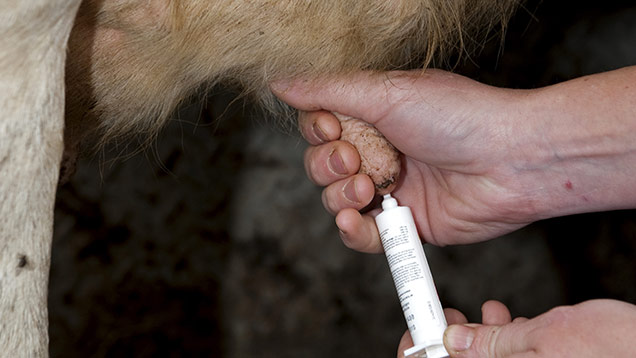Vet Watch: Move away from blanket antibiotics use in dry cows
 © FLPA/Rex Shutterstock
© FLPA/Rex Shutterstock Reducing antibiotic use in dry cow therapy and Johne’s disease in suckler cows are just some of the health issues being observed by vets at XLVets this month. Here’s the monthly round-up.
 Danielle Priestley, St Boniface Vet Clinic, Devon
Danielle Priestley, St Boniface Vet Clinic, Devon
As dairy profit margins remain tight, it is increasingly important to produce high-quality heifers.
Farmers should be aiming to first calve animals at 22-24 months, which means animals have to be well grown by service, and by 12 months of age should be 340kg, with a withers height of 124cm (Holstein). This corresponds to a growth rate of about 0.9kg/day.
We are actively encouraging farmers to weigh heifers, often using the practice scales in the crush at a TB test.
We also suggest spraying a marker line on the wall to assess actual withers height against a target. This provides an early indicator of substandard growth, and still allows time to rectify the problem.
See also: View last month’s round-up, including a metabolic disease risk warning
 John Cammack, Glenthorne Vets, Staffordshire
John Cammack, Glenthorne Vets, Staffordshire
Increasingly some of our dairy farmers are looking at moving away from the blanket use of antibiotics in dry cow therapy for all cows to selective use.
Antibiotic dry cow therapy should be used on cows with clinical mastitis in the previous lactation and those with an individual cell count of more than 150,000 at the last recording.
A teat sealant should be used on all cows not receiving antibiotic tubes to help prevent new infections establishing during the dry period.
Excellent hygiene and a good drying-off procedure are essential. Always discuss with your own vet first before altering drying-off policy.
 Laura Smith, Cain Vet Centre, Powys
Laura Smith, Cain Vet Centre, Powys
We are trying to raise awareness of Johne’s disease among our beef clients. Johne’s can result in significant losses to a beef enterprise, and management can be more challenging as the calves remain with the adult cattle for a long time.
At a recent meeting with Dai Grove-White of Liverpool University, the importance of environmental hygiene was stressed, with the vast majority of infection coming from faecal contamination.
Testing and culling of positive animals remains a critical part of Johne’s control, but you will never tackle the problem in a filthy shed.
 Roderick Dunse, Dunmuir Vet Group, Dumfries and Galloway
Roderick Dunse, Dunmuir Vet Group, Dumfries and Galloway
A diagnostic challenge, which began six months ago with an abortion storm in a herd of housed suckler cows, has finally been resolved.
The initial report was of five abortions in a pen of cattle in 24 hours. Scanning, then old-fashioned rectal and vaginal palpation could only turn up one aborted cow.
The only explanation I could offer was one of the cows was carrying quintuplets.
The farmer called this week to confirm my diagnosis of quintuplets, as all the other cows had calved normally.
